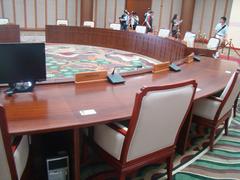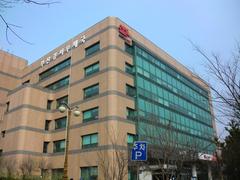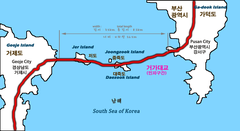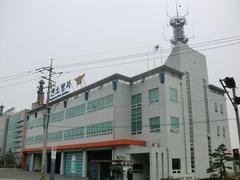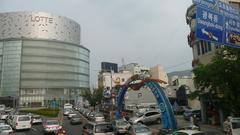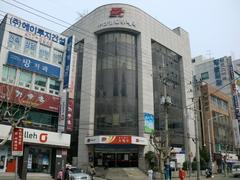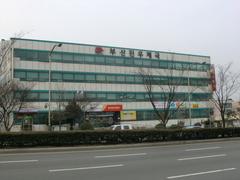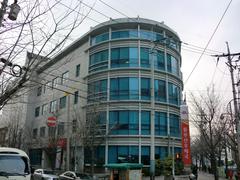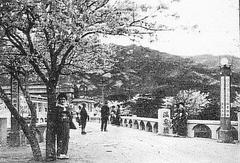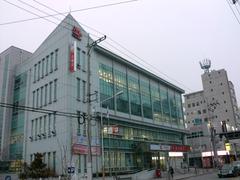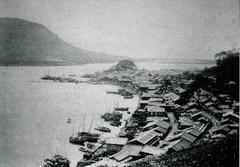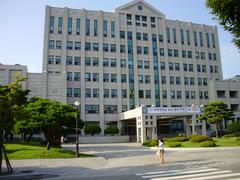Yulli Station Visiting Hours, Tickets, and Travel Guide: Exploring Busan’s Historical Sites
Date: 04/07/2025
Introduction to Yulli Station and Its Role in Busan
Yulli Station (율리역) is a vital transit hub on Busan Metro Line 2, located in the Sasang District of Busan, South Korea. As South Korea’s second-largest city, Busan is celebrated for its blend of maritime heritage, urban vibrancy, and cultural diversity. Yulli Station connects the western and northern districts to the city’s extensive public transport network, making it a convenient starting point for both daily commuters and visitors eager to explore Busan’s cultural landmarks and historical sites (KoreaTripGuide, KoreaTravelPlanning).
Since its opening as part of the Busan Metro Line 2 extension, Yulli Station has been equipped with modern facilities such as elevators, escalators, tactile paving, and bilingual signage, ensuring accessibility for all travelers. The station operates daily from early morning until midnight and supports multiple ticketing options, including rechargeable transit cards like T-Money and Hanaro, which are widely accepted across Busan’s metro and bus systems (PrepareTravelPlans, Road Affair).
Yulli Station has not only improved connectivity but also contributed to the socio-economic revitalization of its surrounding neighborhoods. It provides easy access to attractions such as the Nakdong River Wetlands, Gamcheon Culture Village, Seokbulsa Temple, and the nearby Yulli Monument, which commemorates the region’s industrial heritage (Reddit: KoreaTravel, Busan Tourism Official Site).
This detailed guide covers visiting hours, ticketing, accessibility, nearby historical sites, and practical travel tips to help you make the most of your journey through Busan and Yulli Station.
Contents
- Introduction
- Historical Context of Yulli Station and Busan
- Visiting Yulli Station: Hours, Tickets, and Accessibility
- Socio-Economic and Urban Impact
- Cultural and Historical Attractions Near Yulli Station
- Practical Travel Tips
- FAQ: Yulli Station
- Location and Connectivity
- Beomeosa Temple: Guide and Visitor Information
- Yulli Monument: History and Visitor Guide
- Summary and Travel Tips
- Sources
Historical Context of Yulli Station and Busan
Busan’s Historical Landscape
Busan’s strategic southeastern coastal location has made it a major maritime gateway and cultural crossroads since prehistoric times. Archaeological sites point to human habitation in the area since the Neolithic era. During the Joseon Dynasty (1392–1897), Busan was a designated trading port, fostering commerce and diplomatic exchange. The city’s resilience was especially tested during the Korean War, when it became a critical refuge and the temporary capital of South Korea, leaving a lasting impact on its urban character (KoreaTripGuide, TravelSetu).
Today, Busan is a dynamic metropolis that harmonizes tradition and modernity, with historical sites like Beomeosa Temple and Gamcheon Culture Village standing alongside contemporary skyscrapers and bustling markets (Klook).
The Development of Busan’s Transportation Network
Busan’s first railway station opened in 1908, linking the city to Seoul and facilitating regional growth. The Busan Metro system, launched in 1985, now consists of four main lines and a light rail, supporting millions of passengers annually. The expansion of Line 2, which includes Yulli Station, has improved access to the city’s western and northern districts, promoting balanced urban development (KoreaTravelPlanning, PrepareTravelPlans).
Yulli Station: Origins and Urban Significance
Yulli Station was established during the Busan Metro Line 2 extension to enhance connectivity for residents in the western suburbs and to support the decentralization of Busan’s urban core (KoreaTravelPlanning). The station’s presence has encouraged residential growth, business activity, and community development in the Sasang District.
Visiting Yulli Station: Hours, Ticketing, and Accessibility
Visiting Hours
Yulli Station operates daily from approximately 5:00 AM to midnight, in line with the Busan Metro Line 2 schedule. Trains run at short intervals during peak hours.
Ticket Information
Tickets can be purchased at vending machines in the station, with options for single-ride fares or rechargeable transit cards such as T-Money and Hanaro, which are also valid on buses. Transit cards can be bought and recharged at nearby convenience stores (CU, GS25, 7-Eleven, emart24), allowing seamless transfers across public transit (PrepareTravelPlans).
Accessibility Features
Yulli Station is designed for universal accessibility, featuring elevators, escalators, tactile paving for the visually impaired, and bilingual signage (Klook). The station is barrier-free, accommodating wheelchairs, strollers, and elderly passengers.
Entry and Safety
Entry is through automated ticket gates. Security is ensured by CCTV and on-site staff. Keep your ticket or transit card handy for entry and exit.
Socio-Economic and Urban Impact
The establishment of Yulli Station has revitalized nearby neighborhoods by improving mobility and fostering new business opportunities. Its proximity to industrial parks and logistics centers supports workforce movement and regional economic growth (Reddit: KoreaTravel).
Cultural and Historical Attractions Near Yulli Station
- Nakdong River Wetlands: A haven for migratory birds and native flora, ideal for nature lovers.
- Gamcheon Culture Village: A hillside area known for its colorful murals and artistic spirit, accessible via connecting buses (TravelSetu).
- Seokbulsa Temple: Renowned for its rock-carved Buddha statues and serene mountain setting (KoreaTripGuide).
- Yulli Monument: A landmark celebrating the region’s industrial heritage, within walking distance from the station.
Practical Travel Tips
- Transit Cards: Purchase a T-Money or Hanaro card for easier, discounted travel.
- Navigation Apps: Use KakaoMetro for subway info and Naver Map for bus and walking directions (both offer English support).
- Weather: July is hot and humid (23°C–26°C) with frequent rain. Dress light and carry an umbrella (Weather25).
- Local Amenities: Convenience stores, eateries, and small markets are near the station. Translation apps help with language barriers.
FAQ: Yulli Station
Q1: What are the operating hours?
A1: Approximately 5:00 AM to midnight daily.
Q2: How do I buy tickets?
A2: Use vending machines for single tickets or purchase/recharge T-Money or Hanaro cards at convenience stores.
Q3: Is the station accessible?
A3: Yes, with elevators, tactile paving, and barrier-free design.
Q4: Are guided tours available?
A4: Not at the station itself, but local operators offer tours to nearby sites.
Location and Connectivity
Yulli Station (율리역; 栗里驛) is on Busan Metro Line 2, serving Geumgok-dong, Buk District (Wikipedia). Line 2 connects western districts and Gimhae International Airport to eastern beach areas like Gwangan and Haeundae (Road Affair). Yulli Station’s bilingual signage and unified fare system (T-money, Cashbee, etc.) simplify transfers and navigation (KoreaToDo).
Beomeosa Temple: Guide and Visitor Information
Overview
Beomeosa Temple, established in 678 AD, is one of Busan’s most revered historical sites, located on the slopes of Geumjeongsan Mountain. It is famous for its ancient architecture, tranquil setting, and role in Korean Buddhism.
Visitor Information
- Opening Hours: Daily, 6:00 AM – 6:00 PM (last admission 30 minutes before closing).
- Tickets: Free for the temple grounds; fees apply for cultural programs and temple stays (20,000–50,000 KRW).
- Getting There: Take Metro Line 1 to Beomeosa Station, then a short bus/taxi ride. From Yulli Station, allow ~40 minutes.
- Guided Tours: Available in English via local operators and the temple’s visitor center.
- Accessibility: Some areas have ramps and paved paths; check in advance for mobility concerns.
- Nearby Attractions: Geumjeongsan hiking trails, Seokbulsa Temple, and Yulli Station area markets.
Official Link: Beomeosa Temple Official Website
Sources:
TravelSetu,
Seoul Korea Asia,
Visit Busan
Yulli Monument: History and Visitor Guide
Overview
The Yulli Monument, located in Sasang District, commemorates Busan’s industrial and cultural development. It is recognized for its symbolic sculptures and as a venue for cultural events.
Visitor Information
- Opening Hours: Daily, 9:00 AM – 6:00 PM (last entry 5:30 PM). Admission is free.
- Getting There: 10-minute walk or short bus ride from Yulli Station (Line 2).
- Facilities: Restrooms, seating, multilingual signage, and wheelchair access.
- Events: Cultural festivals, performances, and workshops are held throughout the year.
- Photography: Best during sunrise or sunset for dramatic lighting.
For updates and tour bookings, visit the Busan Tourism Official Site.
Summary & Key Travel Tips
Yulli Station exemplifies Busan’s integration of modern infrastructure and vibrant cultural heritage. It offers efficient transit connections across the city, supports local economic revitalization, and serves as a welcoming gateway for local and international visitors alike (Klook, Road Affair). Its proximity to cultural and natural attractions, such as Gamcheon Culture Village and Nakdong River Wetlands, enables travelers to discover Busan’s unique blend of urban and historical sites (TravelSetu, Busan Metropolitan Government).
Travel Tips:
- Use transit cards (T-Money, Cashbee) for convenience.
- Leverage navigation apps for real-time transit info.
- Prepare for seasonal weather conditions.
- Explore beyond tourist hubs for authentic local experiences.
For up-to-date information, download the Audiala app.
Sources
- KoreaTripGuide: Historical Landmarks and Sightseeing Around Busan
- Wikipedia: Yulli Station
- Busan Tourism Official Site
- Beomeosa Temple Official Website
- Busan Metropolitan Government: History of Busan
- TravelSetu: Busan Tourism Guide
- Klook: Busan Guide
- PrepareTravelPlans: Busan Itinerary
- Road Affair: Visiting Busan Guide
- Weather25: Busan July Weather
- Audiala App

